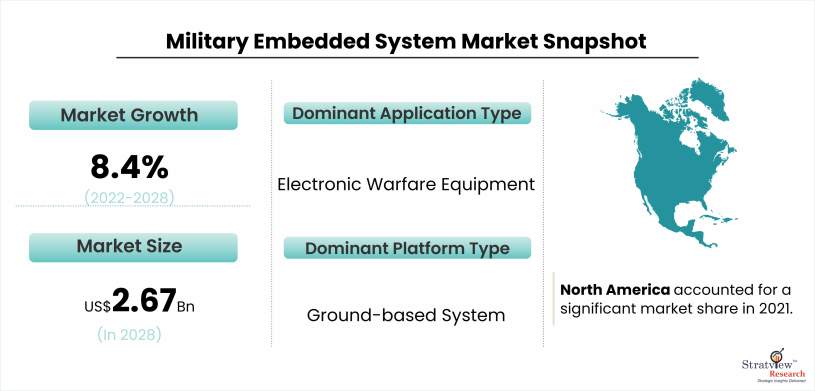In the ever-evolving landscape of modern warfare, technology plays a crucial role in enhancing military capabilities and ensuring strategic advantage. One of the most critical components of this technological advancement is military embedded systems. These compact and specialized computing systems are integrated into various military platforms, ranging from aircraft and ships to ground vehicles and weapons. As we look into the future, it becomes evident that military-embedded systems will continue to shape the way armed forces operate. This article explores the trends and forecasts that will define the future of military embedded systems. The military embedded system market was estimated at US$ 1.52 Billion in 2021 and is expected to grow at a CAGR of 8.4% during 2022-2028 to reach US$ 2.67 Billion in 2028.
Miniaturization and Power Efficiency:
One of the most prominent trends in military embedded systems is miniaturization. The demand for smaller and lighter systems has been steadily increasing, as it allows for greater versatility and ease of integration into various platforms. Miniaturization also enhances mobility and reduces the risk of detection, making it an essential aspect of modern military operations.
Alongside miniaturization, there is a strong focus on improving power efficiency. As advanced functionalities are added to embedded systems, the need for power increases. However, military platforms often have limited power resources. Thus, research and development efforts are directed towards creating energy-efficient solutions that can operate for extended periods without the need for frequent recharging or refueling.
AI and Autonomous Systems:
Artificial Intelligence (AI) is set to revolutionize military embedded systems. AI-driven algorithms can significantly enhance decision-making processes, improve situational awareness, and automate routine tasks. With machine learning algorithms, embedded systems can adapt and learn from past experiences, making them more effective and agile in dynamic environments.
Autonomous systems are also gaining traction in the military domain. Self-driving vehicles and unmanned aerial vehicles (UAVs) are just the beginning. In the future, we can expect to see a proliferation of autonomous systems across various military applications. These systems will not only reduce the human workload but also open up new possibilities for executing missions with precision and minimizing risks to personnel.
Cybersecurity and Resilience:
As military embedded systems become more connected and integrated into larger networks, cybersecurity becomes a paramount concern. The potential consequences of a cyber-attack on critical military infrastructure are severe, ranging from disrupted communications to compromised operations. As a result, investing in robust cybersecurity measures will be a top priority for military agencies and defense contractors.
Moreover, military embedded systems will need to demonstrate resilience against attacks and malfunctions. The ability to withstand cyber threats, physical damage, and extreme environmental conditions is vital for ensuring the continuity of operations. Research will focus on developing systems that can quickly recover from adversarial actions and maintain functionality under challenging circumstances.
5G and Beyond:
The emergence of 5G technology is set to bring about a transformation in military communications and data exchange. The increased bandwidth, low latency, and high reliability of 5G networks will allow military embedded systems to transfer vast amounts of data in real-time. This will enable faster and more informed decision-making on the battlefield.
Beyond 5G, future military embedded systems may leverage even more advanced communication technologies, such as terahertz communications, satellite-based networks, and quantum communication, further enhancing their capabilities.
Interoperability and Open Architectures:
Interoperability is a critical aspect of modern military operations, as different branches of the armed forces and coalition partners must seamlessly communicate and share information. In the future, military embedded systems will be designed with open architectures, allowing for easier integration and data exchange between different systems and platforms. This interoperability will create a more cohesive and efficient military force.
Conclusion:
As technology continues to advance, the future of military embedded systems promises exciting developments. Miniaturization and power efficiency will make these systems more versatile and adaptable, while AI and autonomous capabilities will revolutionize their functionality. However, with these advancements comes the pressing need to prioritize cybersecurity and resilience to safeguard critical military assets.
Furthermore, the deployment of 5G and beyond will enable faster and more reliable communication, enhancing the overall effectiveness of military operations. Lastly, interoperability through open architectures will foster seamless collaboration among different military entities.
By staying at the forefront of technological innovation, military forces can gain a decisive edge on the battlefield, ensuring the safety of personnel and the successful execution of missions. Embracing these trends and forecasts will undoubtedly shape the future of military embedded systems and the way modern warfare is conducted.





Comments